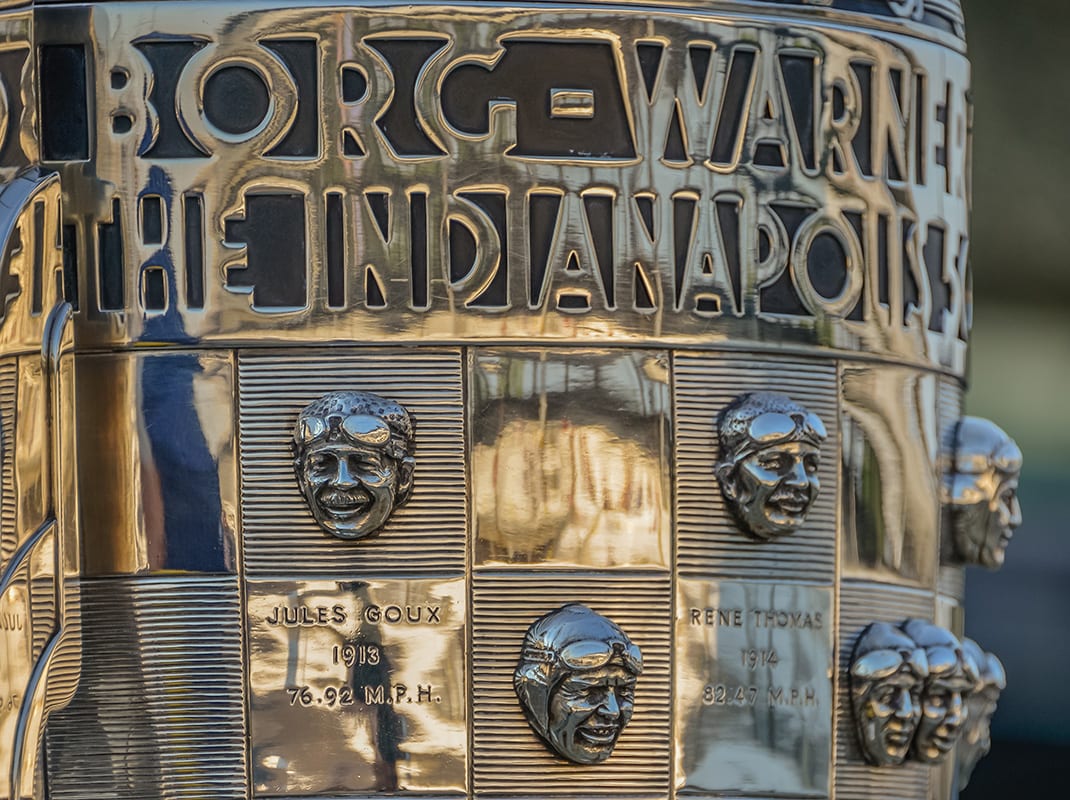Two squares have two heads. This wasn’t done to recognize riding mechanics but rather to recognize co-drivers. There is a distinction made between co-drivers and relief drivers depending on who was in the car at the finish. The initial co-winners were L.L. Corum and Joe Boyer in 1924. The second set came in 1941 with Floyd Davis and Mauri Rose.
Since 1990, the winning drivers’ images have been sculpted by prominent American sculptor William Behrends, who also created the statue of Willie Mays that stands at the entrance to AT&T Park in San Francisco.
The trophy underwent a complete restoration in the fall of 1991. Gorham, Inc., which originally built the trophy, did the work. Silversmith Werner Leyh and chaser Samuel Abaga spent two months removing the faces, repairing the handles, fixing a crack and redoing the lettering. At that time they considered correcting the spelling of the first name of 1950 winner Johnnie Parsons, as it had been misspelled Johnny for more than 40 years. They decided not to change it, adding to the trophy’s lore.
At its home in the museum, the Borg-Warner Trophy is illuminated by four floodlights and it slowly rotates on a base to make it truly shine under those lights.
In the tradition of ancient Greek athletic sculpture, a figure of a naked man is at the top of the trophy. Instead of throwing a discus he’s waving a checkered flag.
A bigger sterling-silver trophy, the Wheeler-Schebler Trophy, is on display beside the Borg-Warner Trophy in the museum. It was presented to the Indianapolis 500 leader after 400 miles in very early races. The Wheeler-Schebler Carburetor Co., which was partly owned by IMS co-founder Frank H. Wheeler, later became the Marvel-Schebler Products Division of Borg-Warner. The L. Straus & Co. Trophy, which was usually an original piece of artwork, was given to the winner each year from 1919 to 1935.

There is one person depicted on the trophy who never won the race. Tony Hulman, owner of the track from 1945 through 1977, is depicted on the base in 24-karat gold. His image was added in 1987 — 10 years after his death — in recognition of his rejuvenation of the track and the race following World War II. One person who knew him told us Hulman was a soft-spoken, humble man and he’s sure Hulman would have declined such a tribute had he known about it.
Tom Sneva is the only winner who appears on the trophy wearing eyeglasses, which was by his request.
The Borg-Warner Trophy has been depicted in at least three movies: “To Please a Lady,” “Winning” and “The Big Wheel.” As usual, Hollywood took some liberties.
There’s a scene in “Winning” where Paul Newman talks on a telephone in a phone booth with the trophy tucked under his arm. This would be highly improbable, considering it takes two men just to lift the trophy.
The trophy used to be polished with Hagerty Silversmith’s Polish, but today two members of the Hall of Fame Museum don’t use polish but simply a jeweler’s rouge (polishing) cloth to clean it, which takes one to two hours. Some weeks in May it is polished daily, depending on the weather it faces during its trips outside the museum.
History, trivia and lore aside, one thing remains constant about the Borg-Warner Trophy. It is a symbol of great achievement, including hard work and teamwork; emotional and financial commitment; athletic and technological excellence and a healthy dose of good luck.
Each driver depicted has realized his dream, and each has earned a place not only on the trophy but also in auto racing history.
